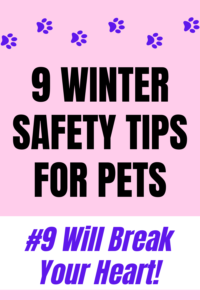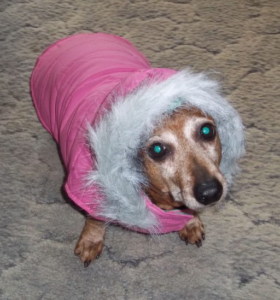There are several dangers for pets during winter that many pet owners aren’t aware of, not all having to do with cold weather. You’ll likely be surprised by some of all of these winter safety tips for pets. #9 will break your heart!
WATCH MY VIDEO: 9 winter safety tips for pets
 9 Winter Safety Tips for Pets
9 Winter Safety Tips for Pets
Here are 9 things to watch out for to keep your pets safe during winter:
1. Ice and Salt on Their Paws. Some of the products used to melt ice on sidewalks or steps can burn the pads of your pet’s feet and can also get stuck between their toes. Boots are ideal if your pet will wear them. You can find a nice selection of inexpensive boots for pets HERE.
If your pet won’t wear boots, then you should always wipe their feet when they come in from outside in the winter. You can keep pet paw wipes next to the door for this purpose.
Keeping the fur on your pet’s feet trimmed during the winter will also help prevent ice and salt clumping. And at your own home, you can use a salt that is safe for pets’ paws. You can purchase Safe Paw Ice Melt HERE.
2. Exposure to the Cold. Prolonged exposure to the cold can be just as dangerous for pets as it is for humans, even for dogs with thick fur. Pets who are left outside too long can experience arthritis flare-ups, hypothermia and even death.
If it’s cold outside, don’t leave your pet outside any longer than necessary. At the end of this article, you’ll find more information about this.
3. Slipping on Ice. My Dachshund, Taz slipped on ice several years ago and seriously injured her back. Watch out for your pets, particularly when you take your dog for a walk or to a park. Things may be slippery.
4. Outside Water Supply. Two things: First, when you leave a bowl of water outside for pets, if it’s freezing outside, the water will freeze. Second, if the water bowl is metal, the animal’s tongue can stick to it just like our parents warned us about when we were kids…don’t lick anything metal!
You can purchase a heated bowl. You can find a selection of these HERE.
5. Space Heaters. It’s not safe to leave a space heater on when you’re not at home. If you must leave one on because it’s your only source of heat, make sure it’s in a safe place where your pet can’t get near it.
Pets will lie on top of a heat vent, sit directly in front of a space heater, of fall asleep in front of, and too close to, a fireplace. If you have pets who do this, check on them often to make sure their bodies or fur aren’t getting too hot.
6. Weight Gain. If you generally walk your dog less in the winter, take that into consideration when you decide how much to feed them. If they’re not doing as much, they generally don’t need to eat as much.
At the same time, remember that no matter what the weather, your dog still needs exercise. Not only for weight control, but to avoid behavioral issues caused by anxiety. Try to take your dog for walks during the winter as much as possible without putting them in danger of exposure.
If it’s cold, put a coat on them and take them for a short walk. If it’s too cold for walks, spend some time playing with them inside.
7. Anti-freeze. So many pets have died because they got into anti-freeze. Pets will lick or drink it because it has a sweet taste. Make sure anti-freeze is always out of your pet’s reach and is immediately cleaned up if it’s spilled, say, on the garage floor.
8. Carbon Monoxide Poisoning. This can happen when your furnace or the furnace vents have leaks. It can be even more dangerous for pets because pets are often left alone for many hours and could be affected long before someone gets home.
The smaller the pet, the less time it would take for them to become seriously ill from carbon monixide. Make sure you have a carbon monoxide detector with working batteries. You can purchase a carbon monoxide detector HERE.
9. Watch Out for Frozen Ponds. This one breaks my heart. If you’re walking your dog in an area where there’s a pond, or if there are ponds near your home, make sure your dog is kept on a leash.
Even if the water appears to be frozen, the ice may not be thick enough to hold the weight of your dog. They could fall through the ice.
Not only when they first step on it, but it could happen once they’re too far out into the pond to make it back. Seriously, I could cry just thinking about this.
 I Hope This Has Been Helpful
I Hope This Has Been Helpful
I hope this article has helped you to know ahead of time the dangers your pet may be exposed to during the winter. Please feel free to comment below if you have more winter safety tips for pets to share.
By the way, that’s my little Dachshund, Taz in the pic wearing her winter coat. Seriously, could she be any cuter? And it gets worse: she’s wearing a onesie underneath!
For More Information
For more about winter pet safety, read these articles:
When is it Too Cold For Dogs? (includes video)
Do Dogs Need Coats in Winter? (includes video)
Keeping Outdoor Cats Warm in Winter (includes video)
Keeping Outside Dogs Warm in Winter (includes video)
Walking Dogs in Cold Weather (includes video)
Cats and Cold Weather (includes video)
Dogs and Cold Weather (includes video)
The ASPCA has a nice article about Winter Safety for Pets.
 I Donate to Animal Charities
I Donate to Animal Charities
Thank you for visiting my website. I donate 10% of my earnings from this website to animal charities. You can see a list of the charities I donate to here.
If you like this website, please share it with your friends and family who have pets, and on social media. Thank you! Debra

 9 Winter Safety Tips for Pets
9 Winter Safety Tips for Pets
 I Hope This Has Been Helpful
I Hope This Has Been Helpful I Donate to Animal Charities
I Donate to Animal Charities

Thank you Debra for this brilliant article! It’s easy to forget that the world is possibly a dangerous place. Anti-freeze is definitely one that scares me the most! Have you had any bad encounters with any of the 9 tips you mentioned? I’ve also never thought about the products they use for ice so will definitely think of that for next winter season!
Just one – my Dachshund slipped on the ice. Poor dog was in so much pain, as was I because the whole incident cost me $1,000 in vet bills! ugh…